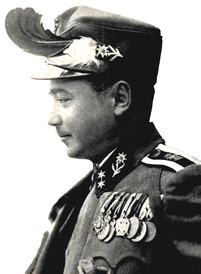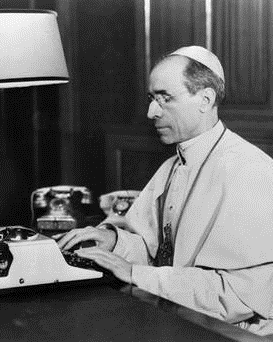 Concordat negotiations: Austria 1933
Concordat negotiations: Austria 1933
This is a rare behind-the-scenes look at the shrewd negotiating tactics of Cardinal Pacelli. (later ) He got the dictator Dollfuss to push through a concordat of dubious legality. After the war, in 1958, the chancellor of a democratic Austria went to the Vatican to cancel the concordat. However, Pacelli, who had meanwhile become Pius XII, would not budge. A concordat, no matter how it is obtained, is permanent.
By Wolfgang Huber
The first push for a concordat came from an Austrian bishop, who wanted to make his job permanent. Ten years after WWI had ended Bishop Sigismund Waitz was still waiting in professional limbo. When national boundaries were redrawn after the war and South Tyrol was ceded to Italy, the Diocese of Brixen was split into an Italian and an Austrian part. Bishop Waitz had been installed as “Apostolic Administrator” of the Austrian part, the district of Innsbruck-Feldkirch, and he wanted this raised to an independent diocese ― with himself as its bishop.
As it turned out, he got his wish: Article 3.2 of the Concordat that was eventually drawn up pledges “the future establishment of the diocese Innsbruck-Feldkirch”. However, the bishop needed a more powerful figure to get the process rolling and was obliged to wait a few years longer until the Austrian Government got involved.
Like the bishop, the Austrian government also had a matter for which it needed Vatican help. This was the marriage question. According to the law of the time Catholic marriages could not end in divorce which led to an ever more untenable situation. An alternative would have been civil marriage, and on more than one occasion there had been a parliamentary majority in favour of this. However, a vote was successfully prevented by the Christian Democrats, so that any solution to this problem was going to have to be with the agreement of the Catholic Church.
At the end of January 1931, therefore, Foreign Minister Johann Schober got in touch with the Vatican, at the same time assuring the Papal Nuncio (ambassador) in Austria that he would do “nothing without the Church and nothing against the Church”. [1]
Less than a month later, however, the scope of the negotiations had widened. On 20 February 1931 Chancellor Otto Enders had himself authorised by Cabinet to sound out the Holy See’s willingness to negotiate a concordat or a modus vivendi. [2]
Immediately there was a flurry of activity on all sides: Vatican, Government and Austrian bishops. Notes were exchanged and talks conducted until on 12 August 1931 Cardinal Pacelli handed the emissaries a draft concordat. The Austrian Government didn’t reply until 9 December 1932, a delay due to several governments falling in the meantime and also to the fact that under these conditions the concordat was not the government’s most immediate concern.
By then the Vatican was interested in getting the negotiating talks resumed as quickly as possible, but they weren’t re-opened until April of the next year. At that point some rumours appeared which could hardly have been better designed to serve the purpose of the Vatican. Vice-Chancellor Richard Smitz noted on 11 April 1933,
 The pressure coming from Berlin and certain news about plans to flood Austria with National Socialist (Nazi) propaganda, to overthrow Dollfuss and make the Anschluss [German annexation of Austria] by peaceful means ― all of this apparently with the knowledge and approval of Mussolini and the Vatican ― made him push forward to Easter Week (11-17 April) the trip he’d planned for later.... [3]
The pressure coming from Berlin and certain news about plans to flood Austria with National Socialist (Nazi) propaganda, to overthrow Dollfuss and make the Anschluss [German annexation of Austria] by peaceful means ― all of this apparently with the knowledge and approval of Mussolini and the Vatican ― made him push forward to Easter Week (11-17 April) the trip he’d planned for later.... [3]
As a result of these rumours Dollfuss spent Easter in Rome trying to make sure that Mussolini wouldn’t betray him to Hitler. After that he attempted to secure the loyalty of the Vatican by rushing ahead with the concordat negotiations. Agreement was reached quickly: on 1 May the treaty was initialled by both sides and on 5 June signed in a solemn ceremony. Not that all this pomp meant revealing the full text, of course. The concordat had a Secret Supplement containing two articles: it kept the changes in the marriage law of Burgenland secret from the Hungarian church which claimed this area and, like the German Reichskonkordat, it kept secret from the rest of the world provisions for the re-armament of Austria.
However, now the concordat was held up by a procedural hitch ― the abolition of parliamentary rule. It couldn’t be ratified right away because on 15 March 1933 Dollfuss had dissolved the democratically-elected parliament and governed by decree. Already by the end of June Cardinal Pacelli was complaining that at the beginning Austria had been in a hurry to conclude a concordat, “but now nothing is moving forward. [4]
And that was not all. Additional pressure was being placed on Dollfuss by statements by the German Vice-Chancellor, von Papen, about the speed with which negotiations for the Reichskonkordat were coming along. Feeling vulnerable Dollfuss asked the Vatican for assurances that the Reichskonkordat was only a concordat between the Holy See and the German Reich, not with National Socialism. Accordingly the Vatican issued an official statement to that effect, all the while winking in the direction of the Nazis. As Cardinal Faulhaber, who helped negotiate the concordat with Hitler, boasted in a 1937 sermon:
At a time when the heads of the major nations in the world faced the new Germany with cool reserve and considerable suspicion, the Catholic Church, the greatest moral power on earth, through the Concordat expressed its confidence in the new German government. [5]
To soothe the impatience of the Vatican, Dollfuss proclaimed at the Catholic Day on 10 September 1933 that in effect the concordat was already being applied. [6]
Before anything further could be done, however, Austria was plunged into chaos. Dollfuss decided to crush the Socialists, the only group who could have been counted upon to help him oppose the Nazis. On 12 February 1934 civil war broke out, but the desperate resistance of the Socialists was doomed from the start. This meant that there wasn’t any danger to the Vatican of losing face by having its concordat repudiated by angry victors.
 However, the conflict did weaken Dollfuss, letting both Hitler and Cardinal Pacelli press their advantages. When the Socialists were crushed on 17 February, the Nazis offered Dollfuss a truce and an ultimatum. [7] The wily Cardinal also jumped in and on 21 February demanded “improvements” to the concordat. A few days later, on 26 February, he became more insistent: “The wishes of the Vatican which were rejected in the negotiation talks due to the parliamentary situation are now, after a fundamentally changed political situation, easier to fulfil.” [8] This "parliamentary situation" which had proven so inconvenient in the earlier concordat negotiations was called “democracy”, but now this no longer stood in the way of “the wishes of the Vatican”.
However, the conflict did weaken Dollfuss, letting both Hitler and Cardinal Pacelli press their advantages. When the Socialists were crushed on 17 February, the Nazis offered Dollfuss a truce and an ultimatum. [7] The wily Cardinal also jumped in and on 21 February demanded “improvements” to the concordat. A few days later, on 26 February, he became more insistent: “The wishes of the Vatican which were rejected in the negotiation talks due to the parliamentary situation are now, after a fundamentally changed political situation, easier to fulfil.” [8] This "parliamentary situation" which had proven so inconvenient in the earlier concordat negotiations was called “democracy”, but now this no longer stood in the way of “the wishes of the Vatican”.
The beleaguered Dollfuss quickly yielded to Cardinal Pacelli. In a Cabinet sitting on 23 March 1934 he reported that the concordat was to be altered. He reported that, “It turns out to be a matter of acceptable modifications” and that “after telephone consultation with the relevant government members, he has decided to fulfil the wishes of the Holy See, whereby he also hoped to avoid new wishes being put forward.... ” [9]
In June, however, the Austrian emissary at the Vatican was made aware that a certain part of the concordat process had not yet been completed. It was expected that the officials of the Vatican Secretary of State receive a consideration. After the emissary asked what amount was required, he had Vienna authorise a payment of 25,000 liras. But how to prove that he had indeed paid the Vatican? He couldn’t exactly demand a receipt from the Holy See. An agreement was reached on a nebulous note and on 10 July he received this note of appreciation which was signed by twenty-four officials, among them a certain Monseigneur Montini, who would later become Pope Paul VI. [10]
Notes
Futher reading: "Österreich / Konkordat: Wer traut?" Spiegel, 16 April 1958. http://www.spiegel.de/spiegel/print/d-41761201.html
1. "Nichts ohne und nichts gegen die Kirche", quoted in Wilhelm Rees, Katholische Kirche im neuen Europa, (LIT-Verlag, 2007), p. 79.
2. In international law a modus vivendi (Latin for a way of living [with something]) indicates a provisional agreement which is to be replaced later with a final treaty.
3. Note cited by Erika Weinzierl-Fischer: Die österreichischen Konkordate von 1855 und 1933, (Wien, Verlag für Geschichte und Politik, 1960), p. 213.
4. Josef Kremsmaier: Der Weg zum österreichischen Konkordat von 1933/34, (Wien, Verband der wissenschaftlichen Gesellschaften Österreichs, 1980), p. 302.
5. Guenter Lewy, The Catholic Church and Nazi Germany (2000), p. 90.
6. Reichspost 10.9. 1933, quoted in Kremsmair, Weg, p. 304.
7. G[eorge] E[ric] R[owe], The Fallen Bastions. (Harper, 1939), p. 121.
8. Kremsmair, p. 307.
9. MR-Protokoll 931, quoted in Ludwig Jedlicka, Rudolf Neck, eds., Vom Justizpalast zum Heldenplatz – Studien und Dokumentationen 1927 bis 1938, (Wien, Staatsdruckerei, 1975), p. 401.
10. Kremsmaier, p. 323ff.







